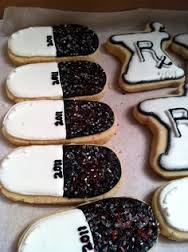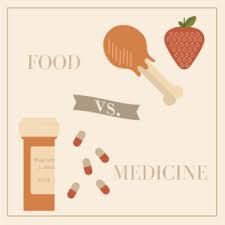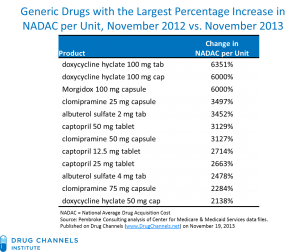by Gabriel Levitt, President, PharmacyChecker.com and Prescription Justice | Dec 19, 2014 | Internet Censorship
We’ve talked a lot about the efforts of the National Association of Boards of Pharmacy (NABP), funded by big pharmaceutical companies, to curtail online access to safe and affordable medication by conflating rogue online pharmacies with safe international online pharmacies: most distressingly through its application to the Internet Corporation for Assigned Names and Numbers. I had the opportunity to present our position about the importance of maximizing online access to safe and affordable prescription drugs by participating on a panel organized by the Internet Society New York Chapter. The focus of the panel overall was on public interest commitments as they pertain to new generic top level domains (gTLD) (i.e., new domain endings such as .book, .amazon, .religion, .nyc, and .pharmacy). Such gTLD’s area acquired through the opening up of this space by ICANN.
The mission of the Internet Society is directly applicable to the issue of online access to affordable medicine: “By connecting the world, working with others, and advocating for equal access to the Internet, the Internet Society strives to make the world a better place.”
The NY Chapter recently held a meeting in my home borough of Brooklyn! Members of the New York Chapter are currently concerned with potential abuses of the .nyc domain space. For example, the organizer of the panel and board member, Thomas Lowenhaput, is concerned that a corporation like Domino’s or Pizza Hut will own the domain pizza.nyc, not only obtaining a commercial advantage but denigrating New York pizza’s culinary cultural soul. The heart and soul of New York pizza has nothing to do with national retail pizza chains so there should be safeguards preventing commercial abuses of those premium domain names. You get the idea!
On the panel, I talked about NABP’s plan to operate the domain space called .PHARMACY because we believe it furthers pharmaceutical corporate interests at the expense of consumers, although in this case the issue is health not pizza! I informed the meeting’s participants that the NABP’s application to ICANN to operate .PHARMACY was funded by pharmaceutical companies and that its domain registration policies will help serve their commercial interests. Not surprisingly, pharmaceutical companies prefer it when consumers pay much more at U.S. pharmacies for the same medications sold in Canadian and other foreign pharmacies at a much lower cost.
NABP’s policies will prohibit a .PHARMACY registration to any non-U.S. pharmacy that sells medication to consumers in the U.S. The basis for its policy mirrors and relies on the discriminatory U.S. and state regulations prohibiting safe personal drug importation. In so doing, NABP is using the levers of Internet governance to support domestic policies that impede consumers from obtaining medications they need. Essentially, in the parlance of the Internet Society, I told the group that NABP’s vision of .PHARMACY undermines the Internet’s promise as a tool to “make the world a better place.”
Tagged with: ICANN, Internet Soceity, NABP, New York Chapter, pharmacy
by Gabriel Levitt, President, PharmacyChecker.com and Prescription Justice | Dec 12, 2014 | Drug Prices, Healthcare Reform, Medicare Drug Plans

A Bittersweet Prescription
OPEN enrollment for Medicare Part D drug plans ended this past Sunday, but my thoughts about them linger. Our website www.MedicareDrugpPlans.com received about 150 ratings of part D plans in 2014 – most of them highly critical, and some of them downright scathing! Whether it’s a plan’s horrible customer service, lack of coverage of many brand name drugs, or dropped coverage, we’re hearing from many irate seniors. At the same time, some studies have shown most seniors are happy with their plans. Why all the contradictions about Part D? To understand, please join me on a trip down Part D memory lane.
When PharmacyChecker.com was founded in 2002, American seniors did not have pharmacy benefit plans through Medicare. While most seniors had some drug coverage through private health insurance or Medicaid, 25% were without any drug coverage and, thus, vulnerable to a pharmacy’s highest retail price. Just eight months after our website launched in April 2003, Congress passed and the president signed the Medicare Prescription Drug, Improvement and Modernization Act of 2003 (MMA), which created a pharmacy benefit opportunity for all Medicare enrollees known as Part D.
It’s amazing and sad to report that, today, the problem of high drug prices for Americans overall is worse than the problems existing before the MMA was born. In 2001, the Commonwealth Fund reported that 28 million Americans did not fill a prescription due to cost. That number shot up to 50 million Americans in 2012!
(more…)
Tagged with: MMA, Part D, seniors
by Gabriel Levitt, President, PharmacyChecker.com and Prescription Justice | Dec 4, 2014 | Internet Censorship, Online Pharmacies
Some consumers who order medication from safe international pharmacies are finding themselves unable to use their VISA credit cards. We hope that doesn’t interfere with their ability to access safe and affordable medication. What’s going on?
Essentially, in taking actions to stop rogue online pharmacies from selling medication, VISA’s online pharmacy policy ends up discriminating against consumers seeking affordable medication from safe international online pharmacies. It appears that VISA has adopted the online pharmacy worldview of LegitScript, a verification service that categorizes safe international online pharmacies as “unapproved” (but not “rogue”) and teams up with big pharmaceutical companies and U.S. chain pharmacies! VISA’s policy may set a precedent for more credit card payment processors; discontinued service to rogue pharmacy websites is good, but if service is discontinued to safe international online pharmacies, including ones approved by PharmacyChecker.com, that’s bad. (more…)
Tagged with: credit card, gatekeepers, Obama Administration, VISA
by Gabriel Levitt, President, PharmacyChecker.com and Prescription Justice | Nov 26, 2014 | Advocacy, Medication non-adherence

People should not have to go without one or the other
As we settle in to our Thanksgiving dinners tomorrow, let’s not forget the many millions of Americans who cut back on groceries each year to pay for medication or simply go without. How prevalent is this travesty? According to Consumer Reports, 21% of American adults with a prescription benefit and 39% without a prescription benefit are cutting back on groceries each year.
According to Hunger in America 2014, 14% of Americans receive charitable food assistance each year – about 46.5 million people. Of those people, 66% had to choose between “paying for food and paying for medicine or medical care in the past year, with 31 percent reporting facing this tradeoff every month.” That’s about 31 million Americans choosing between food and medical care/medicine each year.
The Consumer Reports survey shows that millions of middle class Americans are suffering under the burden of high drug prices. The Hunger in America 2014 survey shows how dramatically the poor are affected.
There is poverty in other advanced economies as well but with much lower rates of people struggling to afford food and medicine. We can do better in America. We hope that PharmacyChecker.com helps alleviate the burden of prescription drug costs and prevents sickness and lives lost when people find medication they can afford by using our information.
A healthy and happy Thanksgiving,
PharmacyChecker Team
Tagged with: food, food or medicine, hunger
by Gabriel Levitt, President, PharmacyChecker.com and Prescription Justice | Nov 21, 2014 | Drug Importation, Drug Prices, Generic drugs, Personal Drug Importation, Politics

From Pembroke Consulting, published on DrugChannels.net
Yesterday, Senator Bernie Sanders (I-VT) held a hearing in front of the Senate Health, Education, Labor and Pensions Subcommittee on Primary Aging and Health entitled “Why Are Some Generic Drugs Skyrocketing in Price?” Bizarre drug price increases of 1,000% and up are becoming more common. This problem is not new: in the beginning of this year the People’s Pharmacy reported a 6,000% increase in the price Doxycycline!
Senator Sanders noted that the price of Digoxin, which treats congestive heart failure, has increased 883% from 12 cents to $1.06 per pill from 2013 to 2014. Migraine drug Divalproex Sodium ER spiked 881% from 27 cents to $2.38 per pill.
We are always ecstatic when Congress scrutinizes the obscene drug prices in America, and we applaud Sen. Sanders, but our focus is on what can be done now so that people today don’t go without needed medications. In his introductory remarks, Sen. Sanders said: “Drug prices in the country are by far the highest in the world.” Let’s elaborate on that. (more…)
Tagged with: Bernie Sanders, Digoxin, Divalproex Sodium ER, FDA, generic drugs, Pembroke Consulting
by Gabriel Levitt, Vice President, PharmacyChecker.com and Sam Werbalowsky, Pharmacychecker.com | Nov 11, 2014 | Drug Prices, Online Pharmacies, Pharmaceutical Industry
Last June we wrote about how Americans taking Nexium – AstraZeneca’s multibillion dollar proton pump inhibitor that treats gastro esophageal reflux disease (GERD) – were losing out on savings due to the FDA’s postponement of a generic version in the U.S. market. Well, it looks like they’re going to wait even longer to find generic copies of the Purple Pill at local pharmacies (and the generic versions probably won’t be purple!). Initially, Indian pharmaceutical company Ranbaxy held exclusive marketing approval to sell generic Nexium in the U.S., but they were banned from actually selling it due to poor manufacturing practices. Well, last week the FDA revoked both Ranbaxy’s approval and its marketing exclusivity for generic Nexium. That might be good for the Purple Pill’s profits (say it fast) – but it leaves consumers singing the blues.
Cash paying Americans are left with the following domestic options: Prescription-strength (40 mg), Nexium or Nexium OTC (20 mg). Prescription-strength Nexium will run you about $600 for 60 pills. That’s a ridiculous price. It’s only $70 to get 126 capsules of Nexium OTC! So, can you just buy Nexium OTC instead of prescription-strength Nexium and just take two pills?
You might be able to, but you need to ask your doctor, pharmacist, or other healthcare provider. I asked my local pharmacist if I could just take OTC Nexium instead, and without hesitation she said I could, but that it may not be as effective and that it comes as a tablet rather than a capsule. The OTC version also has different inactive ingredients, I was told, so if you are allergic to any of those, you should stick with the 40 mg version. She suggested OTC Nexium if I couldn’t make a trip to my doctor or if my insurance didn’t cover prescription Nexium. Even if Nexium is covered, it might be a tier 2 or 3 drug, which could result in your co-pay being higher than the OTC cost.
We’d feel remiss in not reminding you that there are a plethora of proton pump inhibitors on the U.S. market, many that come at a much lower price tag.
But if you need to stick with prescription-strength 40 mg Nexium, it is available from international online pharmacies: 60 pills would be about $50, so it’s actually a better deal than Nexium OTC in the U.S. It’s worth noting that just like the OTC 20 mg pill, the 40 mg purple pill is sold as a tablet, not a capsule, in many foreign markets. You can view our comparisons of Nexium prices.
Hopefully we see these delays sorted out, and a generic version of 40 mg Nexium finally come to market in America. Until then, Nexium OTC at your local drugstore or ordering from an international online pharmacy may be your best options to avoid the drug price blues.
Tagged with: AstraZeneca, Nexium, Nexium OTC, Ranbaxy





